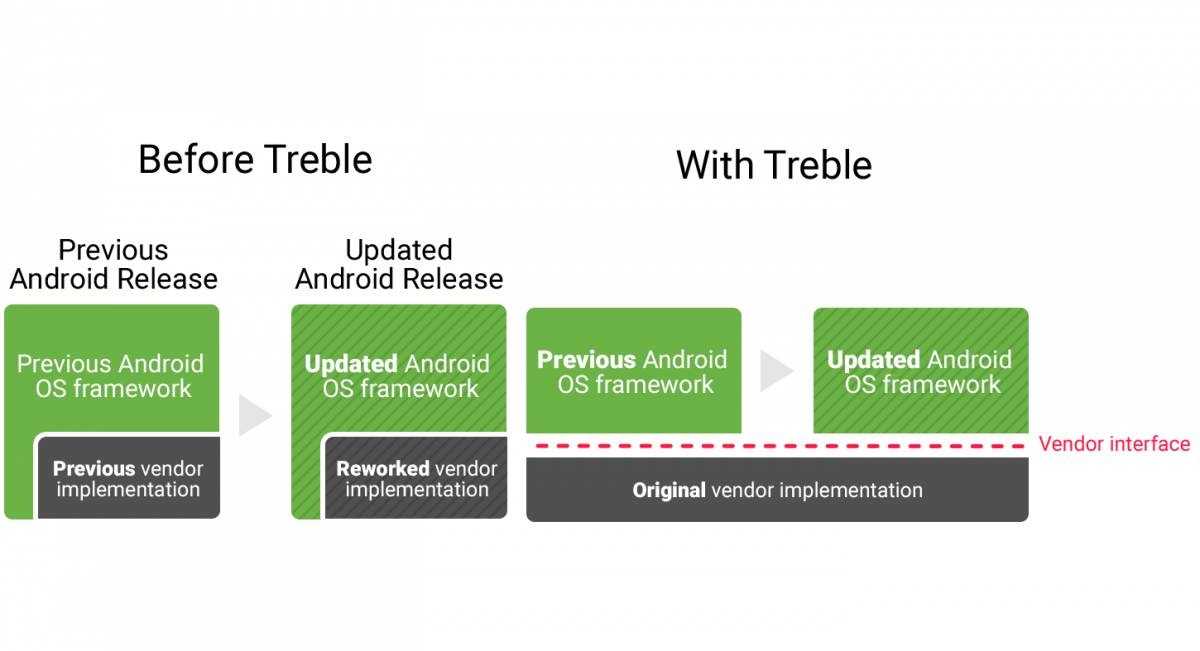Whereas Apple is able to keep most of their devices, even many older ones, up to date with the latest software (which sometimes involve rather controversial features), Android device makers have varying degrees of success keeping their devices up to date. Some device makers like Essential and Google are pretty good at providing security patches, while others can delay updates by months at a time. That's without considering major software updates such as from Android Nougat to Android Oreo, a software release which is installed on only slightly more than 1% of all Android devices. To combat slow Android updates, Google introduced Project Treble.
Project Treble is a major re-architecture in the way Android works. In essence, it separates the Android operating system (the Android 'framework') from the vendor Hardware Abstraction Layers ('HALs') that allow for the OS to work with the device's hardware. Before Project Treble, the Android framework and the HALs usually reside within the same area (the system partition). With Treble, the HALs are moved to their own area (a vendor partition) and now communicate with the Android framework in a more standardized way. The benefit of this is that it allows for companies like Samsung, LG, HTC, and others to work on modifying the stock Android framework while they wait for vendors such as Qualcomm to provide updated HALs. Theoretically, this means that updates should happen more quickly.
For the Android enthusiast community, though, Project Treble has provided another benefit: the ability to quickly boot functioning AOSP ROMs without the need for many hacks. Now, it hasn't been a perfect solution for those looking to enjoy custom ROMs such as LineageOS or Resurrection Remix since there still may be some lingering issues or certain hardware doesn't work because it isn't supported yet in AOSP (such as iris scanners), but it has certainly led to a revolution in custom ROMs for devices that previously never had them.
With how exciting Project Treble is, I'm sure you're wondering if your device is Treble compatible. We have previously written a tutorial on how to check for Project Treble compatibility on your Android device, but to save some of you trouble we'll also be cataloging those devices into a handy list that you can refer to below.
This list will be continuously updated as we learn of new devices updated, both officially and unofficially, with Treble support. This list will not cover every single device that supports Treble—that would make this list too long since Google requires every Certified Android device launching with Android 8.0 Oreo and above to support Treble.
Devices officially updated with Project Treble support
Honor/Huawei
- Huawei Mate 9 (Source)
- Huawei Mate 9 Pro (Source)
- Huawei Mate 10 Lite/Honor 9i
- Huawei Nova 2
- Honor 7X (Source)
- Honor 8 (Source)
- Honor 8 Lite/Huawei P8 Lite 2017 (Source)
- Honor 8 Pro (Source)
- Honor 9 (Source)
- Huawei P10 (Source)
- Huawei P10 Lite
- Huawei P10 Plus (Source)
OnePlus
Xiaomi
- Xiaomi Mi Box (Source)
- Xiaomi Redmi Note 5 Pro (Source)
Miscellaneous
- ASUS Zenfone 4 (Source) - No vendor partition, so cannot flash GSI
- Essential Phone (Source)
- Razer Phone (Source)
- Sharp Aquos S2
Devices unofficially updated with Project Treble support
- LeEco Le Max 2 (Source)
- LeEco Le Pro 3 (Source)
- Lenovo P2 (Source)
- Lenovo ZUK Z2 Plus (Source)
- Lenovo ZUK Z2 Pro (Source)
- LG V30 (Source)
- Motorola Moto G5 (Source)
- Motorola Moto G5 Plus (Source)
- Motorola Moto Z (Source)
- Motorola Moto Z Play (Source)
- OnePlus 3/OnePlus 3T (Source)
- Wileyfox Swift (Source)
- Xiaomi Redmi 4A (Source)
- Xiaomi Redmi Note 4 (Source)
- Xiaomi Mi 3/Mi 4 LTE (Source)
- Xiaomi Mi 5 (Source)
- Xiaomi Mi 5s (Source)
- Xiaomi Mi 5s Plus (Source)
- Xiaomi Mi 6 (Source)
- Xiaomi Mi A1 (Source)
- Xiaomi Mi Mix (Source)
- Xiaomi Mi Max 2 (Source)
- Xiaomi Mi Note 2 (Source)
- Xiaomi Redmi 3s/3X (Source 1) (Source 2)
- Xiaomi Redmi Note 3 (Source)
- Xiaomi Redmi 4X (Source)
- Xiaomi Redmi 4 Prime (Source)
- Xiaomi Redmi Note 5/Redmi 5 Plus (Source)
- ZTE Axon 7 (Source)
If your device receives an update to Android Oreo and you think it should be on this list, please check out our guide on finding out if your device supports Project Treble and leave a comment below so we can update this article!
Also, check out our Project Treble device development forum for all the latest updates on generic custom ROMs like LineageOS and Resurrection Remix! Lastly, check out our guide on how to flash a Generic System Image in case you have a Treble supported device and you want to install a custom AOSP-based ROM!

